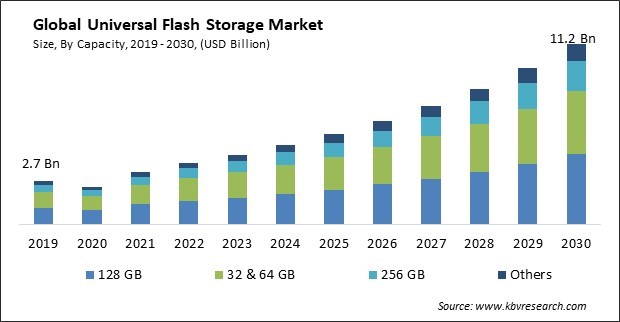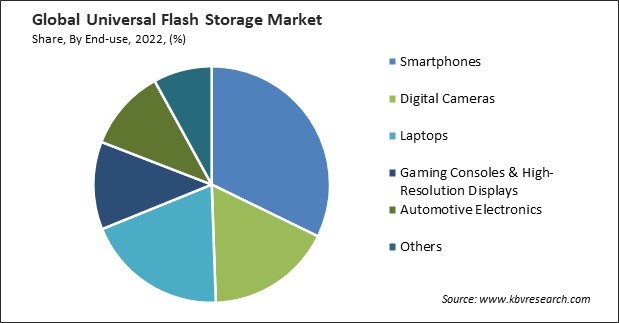
The Global Universal Flash Storage Market size is expected to reach $11.2 billion by 2030, rising at a market growth of 14.5% CAGR during the forecast period. In the year 2022, the market attained a volume of 1,46,315.0 thousand units, experiencing a growth of 18.5% (2019-2022).
Laptops equipped with UFS storage provide users quick access to the operating system, leading to a more efficient start-up process. Consequently, the Laptop segment captured $2,138.5 million revenue in the market in 2022. UFS enhances the speed at which applications launch and operate on laptops. Users benefit from quicker loading times and improved multitasking capabilities, allowing for a smoother, more responsive computing experience. Laptops are widely used for productivity tasks, including document creation, spreadsheet management, and presentation development. UFS technology accelerates the performance of productivity applications, contributing to a more efficient workflow. Some of the factors impacting the market are Increasing demand for high-performance storage, Integration of automotive electronics and ADAS and High cost of UFS technology and its integration.

The proliferation of data-intensive applications, such as high-definition video recording, virtual reality (VR), augmented reality (AR), and resource-demanding mobile apps, has fueled the need for high-performance storage solutions. UFS, with its superior read and write speeds compared to traditional storage technologies like eMMC, caters to the requirements of these applications, ensuring seamless and responsive user experiences. The rise of content creation, including high-resolution photography and 4K video recording, has heightened the need for storage solutions that can handle large file sizes efficiently. The automotive industry is a key growth driver for the development of UFS technology, especially with the rise of advanced driver-assistance systems (ADAS) and in-vehicle infotainment systems. As vehicles become more technologically advanced, the demand for UFS in automotive electronics will continue growing. In addition to safety features, in-vehicle infotainment systems have become a crucial aspect of modern automobiles. UFS contributes to enhanced performance in infotainment processing, supporting features such as high-definition video playback, interactive interfaces, and advanced gaming applications within the vehicle. As a result of the integration of automotive electronics and advanced driver-assistance systems, the market is estimated to grow.
Integrating advanced UFS technology can contribute to the overall cost of electronic devices. Higher-capacity UFS storage solutions with the latest standards may add to the manufacturing costs, influencing the final price of consumer products. Striking a balance between performance, capacity, and cost remains challenging for device manufacturers. The cost of UFS technology is also influenced by supply chain dynamics, including the availability and pricing of key components like NAND flash memory. Original Equipment Manufacturers (OEMs) and Original Design Manufacturers (ODMs) face the challenge of integrating UFS into their devices without significantly inflating costs. The pricing of devices equipped with UFS technology can influence the adoption rates among consumers. If the cost of UFS-equipped devices is perceived as prohibitively high, it may slow consumer adoption. High cost of UFS technology and its integration is a significant challenge that hamper the growth of market.

The leading players in the market are competing with diverse innovative offerings to remain competitive in the market. The above illustration shows the percentage of revenue shared by some of the leading companies in the market. The leading players of the market are adopting various strategies in order to cater demand coming from the different industries. The key developmental strategies in the market are Acquisitions, and Partnerships & Collaborations.
By capacity, the market is categorized into 32 & 64 GB, 128 GB, 256 GB, and others. In 2022, the 128 GB segment held the highest revenue share in the market. The 128GB capacity allows users to store significant data, including high-resolution photos, videos, and large applications. This is especially important for content creators and consumers who engage in multimedia content creation and consumption. The 128GB capacity caters to a broad range of user needs, from casual users who store multimedia content to power users engaged in content creation, gaming, and business applications. This flexibility enhances the appeal of devices equipped with 128GB UFS. Devices with 128GB storage capacity are less likely to reach their storage limits quickly, potentially extending the device's lifespan for users.
On the basis of end-use, the market is divided into smartphones, laptops, digital cameras, gaming consoles & high-resolution displays, automotive electronics, and others. The automotive electronics segment procured a promising growth rate in the market in 2022. UFS technology enables fast data access speeds, leading to quick system boot times for in-vehicle infotainment systems and other electronic control units. This contributes to a more responsive and user-friendly automotive interface. In-vehicle navigation systems benefit from UFS storage's fast read speeds, ensuring quick map loading and efficient route calculation. This contributes to a smoother navigation experience for drivers. UFS technology supports the efficient handling of telematics data, including vehicle diagnostics, maintenance information, and connectivity features. This contributes to improved vehicle monitoring and communication capabilities.

Based on configuration, the market is classified into removable and embedded. In 2022, the embedded segment witnessed the largest revenue share in the market in 2022. Embedded UFS is widely integrated into flagship smartphones, offering faster data access, quicker application launches, and improved overall device performance. As smartphones evolve, the demand for high-speed and efficient storage solutions grows. These devices benefit from the compact size of embedded UFS while delivering high-performance storage capabilities. Embedded UFS suits wearables and fitness trackers, where compact size and efficient data handling are essential. These devices benefit from the speed and reliability of UFS storage.
| Report Attribute | Details |
|---|---|
| Market size value in 2022 | USD 3.8 Billion |
| Market size forecast in 2030 | USD 11.2 Billion |
| Base Year | 2022 |
| Historical Period | 2019 to 2021 |
| Forecast Period | 2023 to 2030 |
| Revenue Growth Rate | CAGR of 14.5% from 2023 to 2030 |
| Number of Pages | 397 |
| Number of Table | 750 |
| Quantitative Data | Volume in Thousand Units, Revenue in USD Billion, and CAGR from 2019 to 2030 |
| Report coverage | Market Trends, Revenue Estimation and Forecast, Segmentation Analysis, Regional and Country Breakdown, Market Share Analysis, Porter’s 5 Forces Analysis, Company Profiling, Companies Strategic Developments, SWOT Analysis, Winning Imperatives |
| Segments covered | Capacity, Configuration, End-use, Region |
| Country scope |
|
| Companies Included | Samsung Electronics Co., Ltd. (Samsung Group), Toshiba Corporation, SK Group (SK Hynix, Inc.), Micron Technology, Inc., Phison Electronics Corporation, Silicon Motion Technology Corporation, Synopsys, Inc., Cadence Design Systems, Inc., Arasan Chip Systems Inc. and LTIMindtree Limited (GDA Technologies, Inc.). |
| Growth Drivers |
|
| Restraints |
|
Region-wise, the market is analysed across North America, Europe, Asia Pacific, and LAMEA. In 2022, the Asia Pacific region led the market by generating the highest revenue share. Asia Pacific is home to diverse industries, and UFS technology finds applications in industrial settings. As the region experiences rapid digital transformation, the demand for high-performance storage solutions in data centers and cloud storage facilities has increased.
Free Valuable Insights: Global Universal Flash Storage Market size to reach USD 11.2 Billion by 2030
The market research report covers the analysis of key stake holders of the market. Key companies profiled in the report include Samsung Electronics Co., Ltd. (Samsung Group), Toshiba Corporation, SK Group (SK Hynix, Inc.), Micron Technology, Inc., Phison Electronics Corporation, Silicon Motion Technology Corporation, Synopsys, Inc., Cadence Design Systems, Inc., Arasan Chip Systems Inc. and LTIMindtree Limited (GDA Technologies, Inc.).
By Capacity (Volume, Thousand Unit, USD Billion, 2019-30)
By End-user (Volume, Thousand Unit, USD Billion, 2019-30)
By Configuration (Volume, Thousand Unit, USD Billion, 2019-30)
By Geography (Volume, Thousand Unit, USD Billion, 2019-30)
This Market size is expected to reach $11.2 billion by 2030.
Increasing demand for high-performance storage are driving the Market in coming years, however, High cost of UFS technology and its integration restraints the growth of the Market.
Samsung Electronics Co., Ltd. (Samsung Group), Toshiba Corporation, SK Group (SK Hynix, Inc.), Micron Technology, Inc., Phison Electronics Corporation, Silicon Motion Technology Corporation, Synopsys, Inc., Cadence Design Systems, Inc., Arasan Chip Systems Inc. and LTIMindtree Limited (GDA Technologies, Inc.).
In the year 2022, the market attained a volume of 1,46,315.0 thousand units, experiencing a growth of 18.5% (2019-2022).
The Smartphones segment is leading the Market, by End-use in 2022; thereby, achieving a market value of $3.4 Billion by 2030.
The Asia Pacific region dominated the Market, by Region in 2022, and would continue to be a dominant market till 2030; thereby, achieving a market value of $4.2 Billion by 2030.
Our team of dedicated experts can provide you with attractive expansion opportunities for your business.
